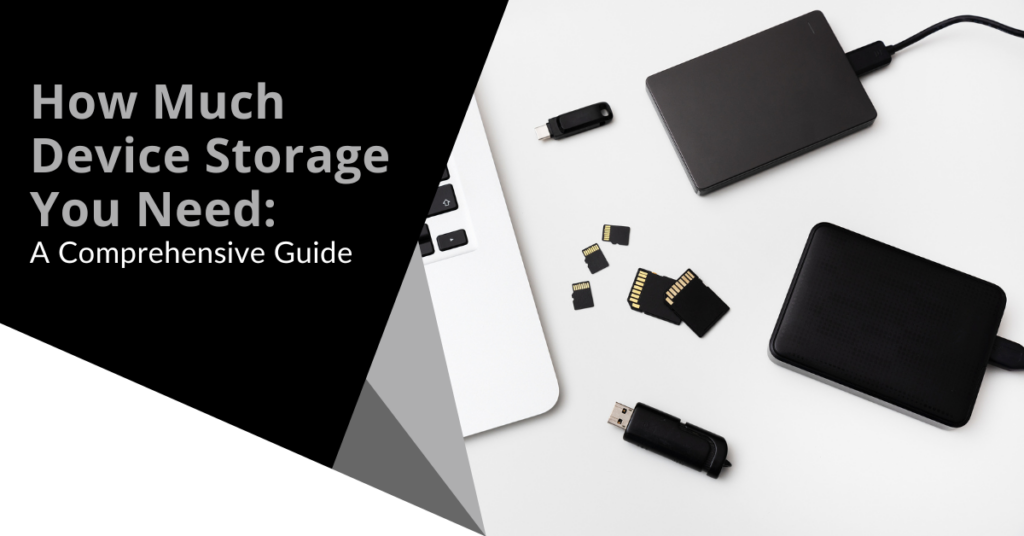|
Getting your Trinity Audio player ready...
|

Your device storage determines how many files and apps and photos and videos you can maintain before performance degradation occurs. Running out of storage on your device produces major negative impacts on productivity and system performance. Which level of storage space does your situation require?
A detailed evaluation of device storage selection processes and management strategies follows.
What Is Device Storage?
Your smartphone, tablet, laptop and desktop contain digital storage areas known as device storage which holds your digital data. Your device includes all files and applications together with videos and photos and downloads and system files. Your device’s usability will suffer when its storage capacity reaches its maximum because new content storage and update installation become impossible.
There are two main types of device storage:
- The built-in storage system of your device which operates faster than other types. The operating system together with most applications depend on this storage which cannot be extracted from the device.
- External Storage consists of three elements: SD cards, USB drives and external hard drives. Storage expansion becomes possible through these components but they function at reduced speeds.
The available storage capacity for different device types follows these ranges:
- The starting capacity of smartphones begins at 64GB but premium devices now reach up to 1TB. The storage capabilities of Android phones exceed those of iPhones because they support external options.
- Tablets usually start with 32GB to 256GB of storage but some models include memory card slots for additional expansion.
- Laptops have capacities between 128GB and 1TB or higher while users can add more through internal drive upgrades.
- Desktop computers offer storage options ranging from 1TB to 4TB and beyond. These devices are the most flexible for enhancing device storage.
How Much Device Storage Do You Need?
Your storage requirements depend entirely on your personal activities. Too little leads to user irritation while excessive capacity purchase results in unnecessary financial loss.
Let’s break it down by user type:
Casual Users
The essential requirements of web browsing, email checking, and occasional photo capture can be handled with 64GB of device storage.
Everyday Users
Users who install apps, take frequent photos, and store short videos should have between 128GB to 256GB.
Heavy Users
Video editors, mobile creatives, and gamers need extensive capacity. The demands of games, high-resolution images, and raw video files call for at least 512GB.
Professional Users
Content creators, data analysts, and 4K video producers often need device storage of 1TB or more to manage large files and software.
Tips for Managing Device Storage More Efficiently
Your experience suffers when capacity isn’t well-managed, even if it’s sufficient. Follow these tips to maximize available device storage:
- Free up space using cloud services such as iCloud, Google Drive, and OneDrive.
- Delete unused apps, which take up space for no reason.
- Clear cached temporary files regularly to recover storage.
- Stream music and video instead of downloading to preserve capacity.
What Uses the Most Device Storage?
Storage needs vary by file type:
- 4K or HD videos consume several gigabytes of device storage per file.
- High-resolution photos accumulate quickly when not backed up or deleted.
- Modern mobile and PC games can exceed 50–100GB.
- Video and photo editing tools create large project files that require substantial storage.
What to Do If You Run Out of Device Storage
When you hit your limit, there are three dependable solutions:
- Add SD cards or external drives if your device supports them.
- Move your files to a protected cloud-based system.
- Upgrade to a device with more built-in device storage capacity.
Choosing the Right Device Storage for Your Next Purchase
Before buying a new device, analyze your future needs. Consider your app usage, media collection size, and whether you work with large files.
Most users should choose devices with more device storage than they think they need. This helps prevent future performance issues.
Final Thoughts
The device storage spec often gets overlooked but plays a key role in device performance. Understanding your habits helps you choose a device that balances affordability and performance. Effective device storage management benefits everyone—from casual users to creative professionals.
If you’re unsure about the right capacity for your upgrade, our team is ready to help you select a device with the ideal combination of speed, performance, and storage.
Twintel has grown into an expansive, full team of IT services professionals, acting as the outsourced IT department of non-profits, small to mid-size businesses, and enterprise-level corporations in Orange County, across California, and nationally.
Today, it’s the strength and deep expertise of the Twintel team that drives positive outcomes for clients. Each of the support staff, technicians, and engineers works diligently each day to make sure that the companies served have the seamless, secure, and stable IT environments needed to allow them to pursue their organizational objectives.